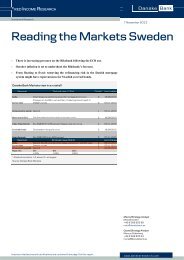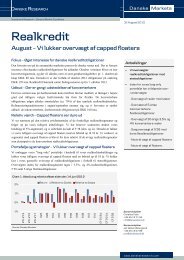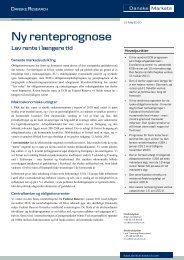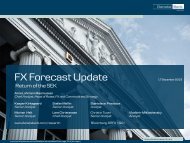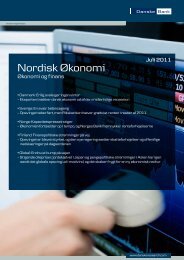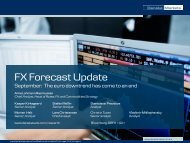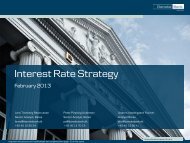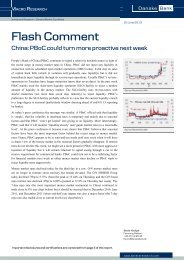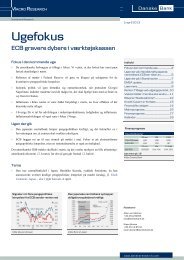Global Scenarios - Danske Analyse - Danske Bank
Global Scenarios - Danske Analyse - Danske Bank
Global Scenarios - Danske Analyse - Danske Bank
Create successful ePaper yourself
Turn your PDF publications into a flip-book with our unique Google optimized e-Paper software.
<strong>Global</strong> <strong>Scenarios</strong><br />
This is already taking its toll on growth in the near term even with the cushion<br />
from declining commodity prices.<br />
To assess the impact we have simulated two scenarios; one with no shock<br />
(i.e. financial variables fixed at the end-April levels) and one with the current<br />
shock (i.e. financial variable fixed at the current level).<br />
The scenarios indicate that if the market conditions do not improve GDP<br />
growth is likely to take a hit of 1-1½pp in H2 10 and ¾pp through 2011. The<br />
simulations also demonstrate that the growth rate would probably have approached<br />
4% in H2 if it has not been for the contagion on global financial<br />
markets.<br />
<strong>Scenarios</strong><br />
No Shock Current Shock<br />
2010 2011 2010 2011<br />
Year end<br />
Year end<br />
S&P500 1265 1391 1069 1176<br />
10 year govenrment bond 3.7 3.7 3.1 3.1<br />
Real Effective Exchangerate 87 87 90 90<br />
Credit Spread* 241 241 310 310<br />
Libor Spread 15 15 26 26<br />
NYMEX WTI 85 85 70 70<br />
*) Moody's Baa rate minus 10yr US Treasury yield<br />
Source: Reuters Ecowin and <strong>Danske</strong> Markets<br />
The assumption behind our forecast is that the intervention from fiscal and<br />
monetary authorities will finally succeed in calming down the markets. In<br />
this scenario the recovery will remain intact. There will be a cost from the<br />
turmoil in the short run, but it will to some extent be paid back later on.<br />
Contagion could speed up manufacturing slowdown<br />
Over the past three quarters the US manufacturing sector has experienced a<br />
classical V-shaped recovery. The manufacturing ISM index reached a cyclical<br />
high of 60.4 in April, but fundamentals now suggest that leading manufacturing<br />
indicators are very close to a peak and that the pace of manufacturing<br />
growth is bound to slow in H2.<br />
This should in fact be of little surprise. Production has been expanding faster<br />
than demand over past quarters and the gap between the two has narrowed.<br />
As output catches up with demand, production growth will eventually settle<br />
down to more average levels. We are now close to this point in the cycle and<br />
the ISM is set to move lower in H2.<br />
While fundamentals are suggesting that the descent in the ISM will be relatively<br />
moderate, the recent deterioration in financial market conditions could<br />
speed up the slowdown in the manufacturing sector. Discounting the recent<br />
turmoil ISM should be heading for 54-55 by year-end. However, in the event<br />
that conditions do not improve these levels could be reached as early as November<br />
and the ISM would reach 50 in Q1 (see Euro crisis could speed up<br />
manufacturing slowdown).<br />
GDP growth under different scenarios<br />
5.00 % q/q AR % q/q AR<br />
4.50<br />
4.00<br />
No shock Current shock with<br />
no improvement<br />
3.50<br />
GDP forecast<br />
3.00<br />
2.50<br />
2.00<br />
1.50<br />
Q2 Q3 Q4 Q1 Q2 Q3 Q4<br />
10 11<br />
Source: Reuters Ecowin and <strong>Danske</strong> Markets<br />
5.00<br />
4.50<br />
4.00<br />
3.50<br />
3.00<br />
2.50<br />
2.00<br />
1.50<br />
Inflation to stay low but deflationary trap unlikely<br />
Core inflation dropped to 0.9% y/y in April, its lowest level since 1963. A<br />
major disinflationary impulse from the housing component is currently dragging<br />
core service price inflation lower and there are no signs of a turnaround<br />
in housing inflation any time soon. Service prices outside housing are usually<br />
very stable, but with a major slackening in the labour market, we believe that<br />
this inflation component will move lower as well.<br />
Outside services, there is evidence of upward pressure on core goods prices.<br />
Core crude and intermediate PPI has surged over the past year, but a sharp<br />
decline in unit labour cost growth has offset the upward price pressure and<br />
finished goods PPI has kept relatively stable. We expect the downward trend<br />
in unit labour cost growth to continue keeping a lid on core goods inflation.<br />
The disinflationary trend to continue for a while<br />
6<br />
5<br />
4<br />
3<br />
2<br />
1<br />
% y/y % y/y<br />
CPI<br />
Core CPI<br />
0<br />
-1<br />
-2<br />
02 03 04 05 06 07 08 09 10 11<br />
Source: Reuters Ecowin and <strong>Danske</strong> Markets<br />
6<br />
5<br />
4<br />
3<br />
2<br />
1<br />
0<br />
-1<br />
-2<br />
12 | June 2010<br />
www.danskeresearch.com



